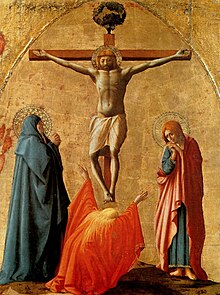

The Pisa Altarpiece (Italian: Polittico di Pisa) was a large multi-paneled altarpiece produced by Masaccio for the chapel of Saint Julian in the church of Santa Maria del Carmine in Pisa. The chapel was owned by the notary Giuliano di Colino, who commissioned the work on February 19, 1426 for the sum of 80 florins. Payment for the work was recorded on December 26 of that year. The altarpiece was dismantled and dispersed to various collections and museums in the 18th century, but an attempted reconstruction was made possible due to a detailed description of the work by Vasari in 1568.[1]
It was a tempera painting on a gold ground and wood panel. It originally had at least five compartments organised in two registers, making ten main panels, of which only four are known to have survived. Another four side panels and three predella panels (two of which had a double scene) are now in the Gemäldegalerie, Berlin.[2] The altarpiece's central panel was Madonna and Child with Angels, produced in collaboration with Masaccio's brother Giovanni and with Andrea di Giusto, now in the National Gallery, London.
Eleven panels are known as of 2010, and they are insufficient to reconstruct the whole work with certainty. In particular four standing figures of saints flanking the central panel are missing. Vasari says these were the saints shown in the predella narrative scenes: Peter, John the Baptist, Julian and Nicholas. In particular it is unclear if these larger saints occupied the more traditional individual framed compartments, as proposed by C. Gardner von Teuffel and others, or stood in a unified field with the central Virgin and Child, as proposed by John Shearman, which was to become the usual style in the following decades.[3]
- ^ Giorgio Vasari, Le vite de' più eccellenti pittori, scultori ed architettori, ed. Gaetano Milanesi, Florence, 1906, II, 292.; online translation
- ^ "Altarpredella / Die Kreuzigung des Apostels Petrus und Die Enthauptung Johannes des Täufers". Staatliche Museen zu Berlin. Retrieved 2024-04-19.
- ^ Central area, per John Shearman